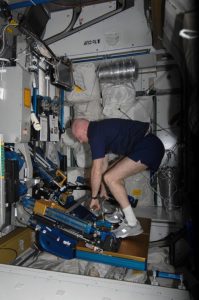Back Pain in Astronauts, Lessons from Outer Space
Back Pain In Astronauts
What can back pain in Astronauts teach us about back pain on earth? Back pain is the leading cause of disability in people living and working on earth. It seems that back pain is even more of an issue for Astronauts that travel into space. Back pain during space flight has been reported in over 53% of Astronauts with 28% reporting significant back pain. On return to earth Astronauts are at a much higher risk of herniating a spinal disc.
The issue of low back pain in Astronauts was examined by a group of top spine researchers that were selected by the European Space Agency. Their findings were published in the European Spine Journal. The researchers highlight several issues that may lead to back pain in Astronauts. What is it about space travel that puts an Astronaut at higher risk of low back pain?
- The spinal discs of Astronauts may swell while in space. The overhydrated disc is at higher risk of developing a disc herniation. The disc pressure increases after being in a weightless environment such as space.
- In space Astronauts lose their natural spine curves. If you feel the hollow in your lower back when you are standing you are feeling one of the natural curves in your spine. These spinal curves are flattened in space increasing spinal height by 4 to 6 cm.
- The small muscles of the spine lose some of their muscle mass. This affects the ability of their muscles to support their back during everyday movements. This makes Astronauts more prone to back injury.
Back Pain on Earth:
So what can we learn about low back pain in Astronauts that help us manage our low back pain here on Earth? Astronauts seem to get relief in space from stretching into a fetal position. Stretches such as pulling your knees to your chest, stimulates the muscle stretch receptors, giving temporary pain relief. Conversely, this stretch can cause cumulative tissue strain by placing the spine into the forward bent position (McGill, 2010).

Astronaut doing a dead lift using the Advanced Resistive Exercise Device (ARED). NASA photo.
Secondly, according to a study published in Spine, Astronauts were doing some exercises that can cause low back pain. The exercises were designed to keep Astronauts from losing muscle and bone mass while in space. Many of the exercises they were doing were excellent exercises. Some of the exercises such as dead lifts and squats can put the spine at risk of injury. The NASA picture shows an Astronaut in a high risk position. He is reaching into full forward spine bending while pulling on the resistance cable. This replicates the mechanism for herniating a spinal disc.
So what are the important points for people with low back pain on Earth?
- Don’t bend the spine first thing in the morning. You have more fluid in your spinal discs after sleeping all night. This increases pressure in the disc making them more prone to herniating with forward bending, even bending down to pick up your socks. Instead of bending your spine, spend time upright walking around warming up your spine. Avoid as many spine bends during the day as you can; repeat bending is hard on the spinal discs. When bending keep your spine in a neutral position bending more from your hips.
- Don’t do heavy lifting or exercising first thing in the morning. It is important not to do heavy loading when your spinal discs have increased hydration. When doing exercises such as squats and deadlifts don’t go down too far allowing the spine to round forward. It is also important to understand that strength training doesn’t protect your back from pain or injury. Back safe exercises are designed to increase your muscle endurance, not strength. Professor Stuart McGill from the University of Waterloo shows safe back exercises that keep your spine in a neutral position while doing low load exercises (see New York Times video).
- Stretch the arms and legs not the spine. Astronauts have a lot of spine stiffness in space. You would think that spine stretches would be good to do. It turns out that those with more spine flexibility are more prone to low back pain. According to Professor Stuart McGill, the muscles of the arms and legs generate motion and can be stretched. The muscles of the spine have the opposite function, they prevent motion. So avoid stretches such as bringing your knees to chest and bending over to touch your toes.
- Finally, if you have low back pain, try to stay active within the limits of your pain. Staying active keeps the muscles from becoming weakened from inactivity which can happen with too much bed rest.
Most of us will not be travelling into space any time soon but we may be dealing with low back pain. I hope these suggestions help you deal with your low back pain while on earth.
Paul S Nolet, DC, MSc, MPH, FRCCSS(C)
Chiropractor
